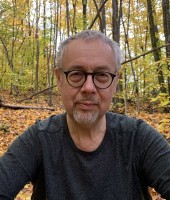Jeremy Stolow
Jeremy Stolow is Professor of Communication Studies at Concordia University, Montreal, Canada, where he teaches and conducts research at the intersections of religion and media, history of science, culture and technology, and visual studies.
His previous research focused on the history of Jewish Orthodox print culture, on Spiritualism and electricity in the 19th C, and on the history of efforts to photograph 'the human aura' and the lives of such pictures in diverse realms of parapsychology, art photography, popular culture, and the New Age alternative medical and spiritual marketplace. Over the years, he has been a visiting scholar at Cambridge, New York University, Utrecht University, and the Netherlands Institute for Advanced Study, and has participated in numerous international collaborative research projects in religion, media, and culture.
In September 2025, Jeremy Stolow joins the Paris IAS for a ten-month research stay.
Research topics
History of Rejected Sciences; Esotericism and Culture; Chromotherapy.
The Colour Cure: A History of Chromotherapy and its Techno-Culture
This project concerns the history of chromotherapy (CT), an alternative medical practice that uses coloured lights, materials, and built environments to sustain health and vitality, restore calm minds and bodies, and enhance spiritual growth. Since the late 19th C, CT has been shaped by waves of scientific interest, esoteric commentary, public curiosity, legal controversy, and commercial exploitation, culminating in the present-day ‘New Age’ global marketplace for alternative medicine and spiritual care. But CT principles and motifs have also enjoyed a surprising and largely unexamined history of entanglement in other domains, from scientific management to art education to psychology, as in the case of colour schemes applied within factories, schools, hospitals, prisons, and other institutional settings. The project explores the ways CT has served both as a vehicle of spiritual and body care and as a storehouse of practices and ideas taken up in diverse professional and cultural settings. Through the assembly and analysis of an archive of primary sources – scientific studies, journalism, legal proceedings, patents, technical reports, visual records, and material culture – it will trace CT’s evolution, its international spread, its scientific and legal controversies, and especially, its instruments and techniques.
The project's ultimate goal is to recount the history of this healing technique, its persistence in the face of trenchant critique from orthodox biomedical experts, and the esoteric understandings of life, body, and cosmos that are enacted through its practice. This account fills key gaps in knowledge about an unfamiliar and poorly understood history. At the same time, both in its empirical findings and in its method, this project will generate new insights and points of intervention into ongoing theoretical discussions that resonate across the human sciences, including debates about the boundaries dividing science, religion, and culture; about technological modernity and enchantment; and about medical pluralism and ontological difference.
Key publications
Jeremy Stolow. Picturing Aura: A Visual Biography, The MIT Press, 2025.
Available here: https://mitpress.mit.edu/9780262551748/picturing-aura/
Jeremy Stolow. Deus in Machina: Religion, Technology, and the Things in Between, Fordham University Press, 2013.
DOI: https://doi.org/10.2307/j.ctt13x095h
Jeremy Stolow. Orthodox By Design: Judaism, Print Politics, and the ArtScroll Revolution, University of California Press, 2010.
Available here: https://www.jstor.org/stable/10.1525/j.ctt1ppt6s
|
Book Présentation Picturing Aura by Jeremy Stolow (Concordia University, Paris IAS) at Netherlands Netherlands Institute for Advanced Study (NIAS). Open to the public, registration required. Lecture by Jeremy Stolow (Concordia University, Paris IAS) at the Center for Advanced Studies in the Humanities and Social Sciences, in Erlangen Germany. Open to the public, registration required. Round table followed by a discussion of Jeremy Stolow's book Picturing Aura (Concordia University, Paris IAS) at the Warburg Institute in London |
|
|
|
|




